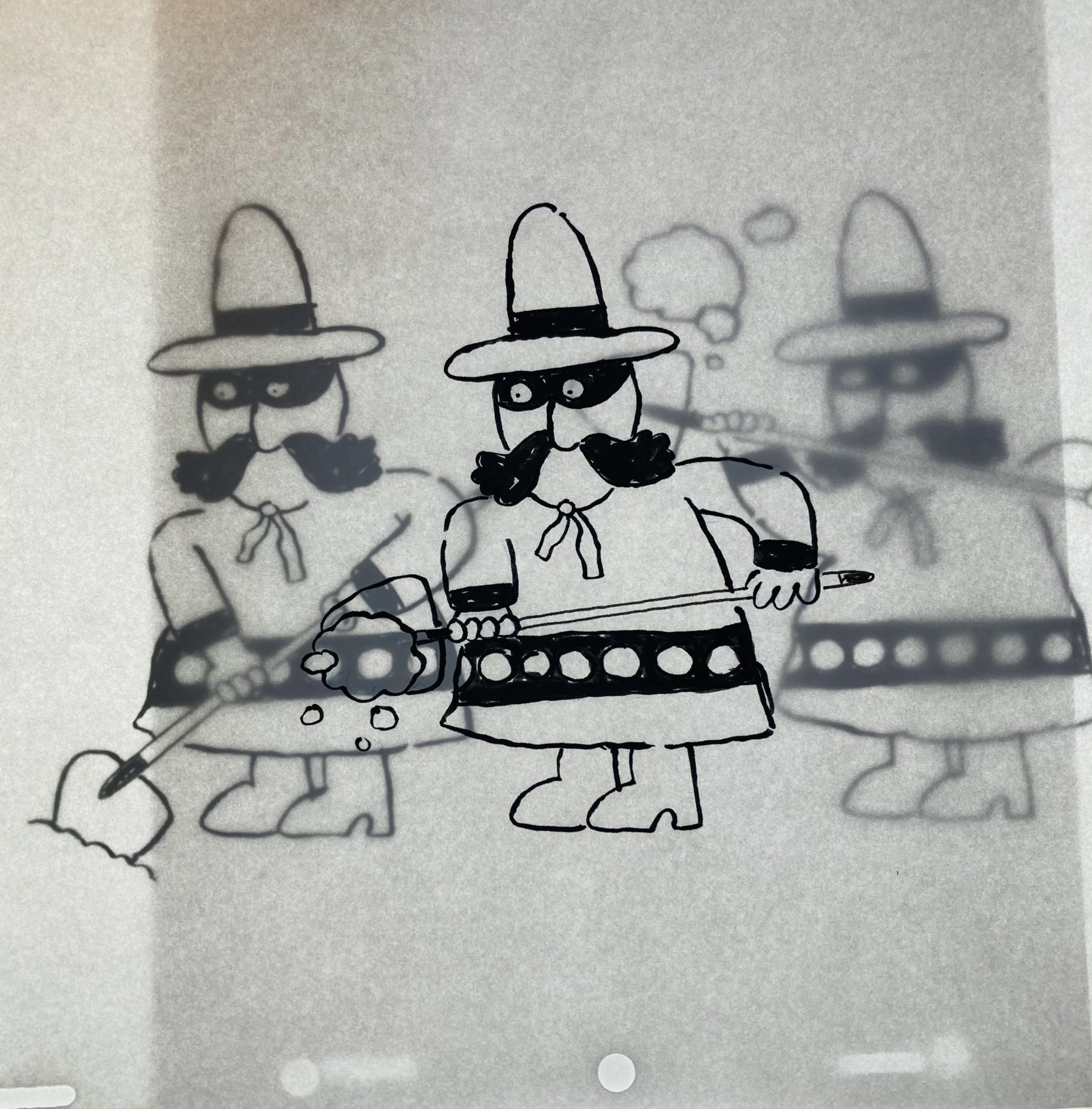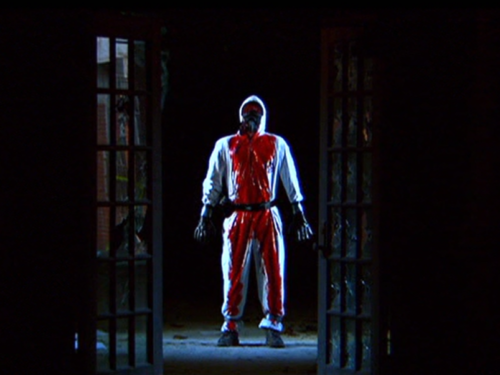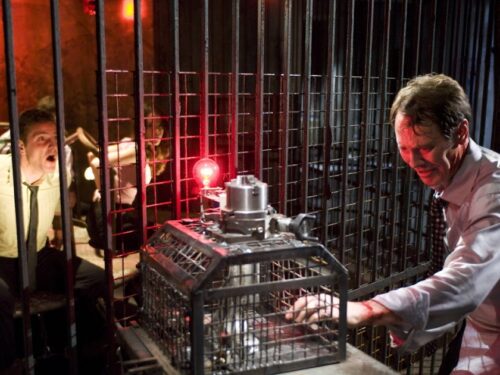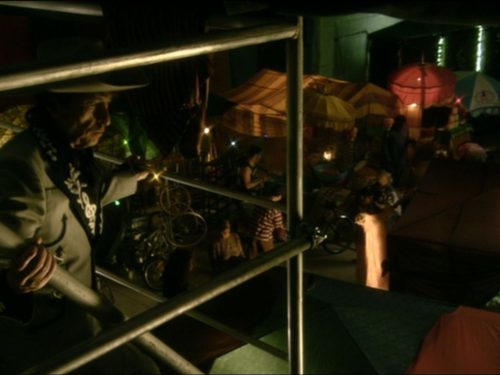With a style inspired by mid-century analog animation techniques, Neeley’s films and music videos take rudimentary elements to abstract places
Mark Neeley is an animator whose films are the result of meticulous analog technique, a deep understanding and appreciation of animation history, and the blending of this passion for visual art with his love of music.
Neeley’s acclaimed short film Fragments was released in 2020, when it had a successful festival run during the pandemic. He animates for The Aquarium Drunkard Picture Show, and is known for creating music videos for artists like Michael Rault, Maston, Spencer Callum’s Coin Collection, Psychic Temple, Cactus Lee, and Frankel. Neeley is also a writer and researcher, who has explored topics ranging from music and film to underground newspapers.
In an email interview we spoke about the rigors of creating purely analog animation, the legacy of the Hubleys, and gaining a new appreciation for the connection between sound and image.
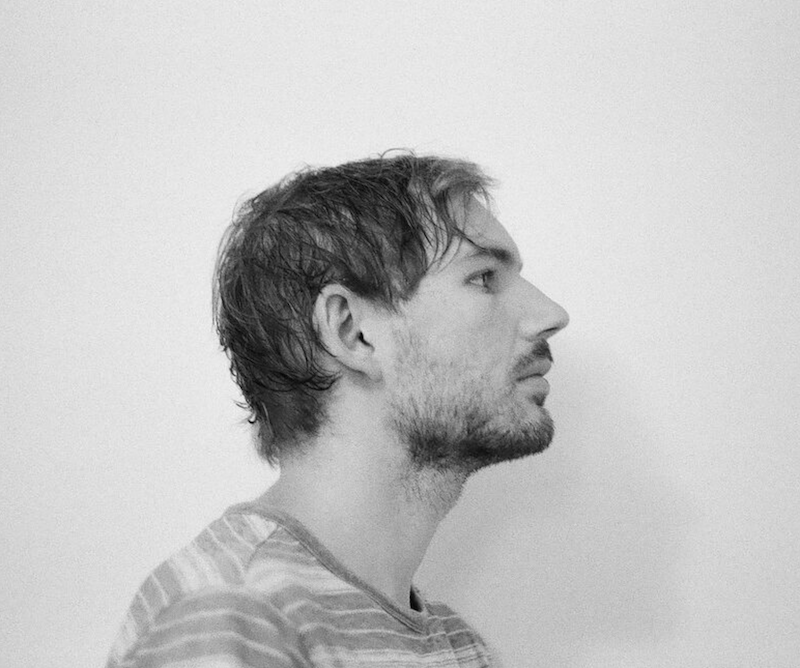
Split Tooth Media: You’ve described your animation as very old school, and that you are “inspired by the spirit of mid-century independent animation.” What draws you to this methodology and to that era specifically?
Mark Neeley: In the beginning, I was drawn to it because it looked like something that I could actually emulate. I was too intimidated to draw something with the sort of stylized realism of Disney. But when I first saw these obtuse looking indie shorts, I thought, ‘I can do designs like that!’ The artwork was more minimal and charming, and limited animation seemed more achievable. Something like Richard Condie’s The Big Snit (1985) was an early one I saw like that. There used to be a cable program that aired late at night called O Canada which showed that and all of these independent short films from the National Film Board.
As a kid that was so mysterious to me, because it was presented without any context. Later I would recognize some of these when I found library books like Kit Laybourne’s The Animation Book (1979) which showcased all of these independent animators and mediums from around the world. Those taught me that animation could be done without a studio staff of 200 people. And that’s how I taught myself to animate, via primitive homemade flip books and stuff like that. Even in that era when everything was moving digital by the late nineties, I was learning to animate the old fashioned way on paper.
I think some people think that my work is deliberately “retro,” trying to achieve a specific vibe. In actuality though, I am working the only way I know how to work. And I do love all of that stuff — the tactile feel of hand drawn animation, where sometimes you seem like you actually feel the artist’s fingerprints on their work. There was a musician, it might have been Stephen Malkmus, who once said that when an artist creates something, it’s always partially an homage to something that came before it as much as it is truly original. I guess I subscribe to that mentality as well. I’ve never been shy about my own influences.
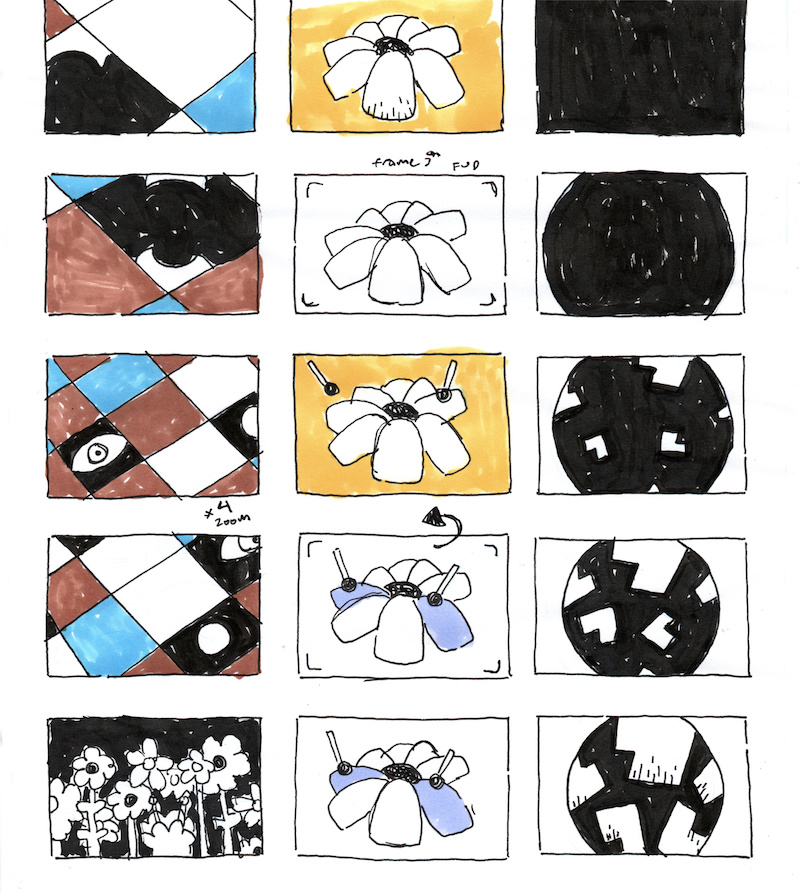
What is the animation process like utilizing only lightbox and paper, and how do the results of this practice compare to more modern animation methods?
The process typically begins with a storyboard, though I keep it loose. From here it really depends on the project, something like a music video requires a lot more planning and structure since they are typically 3-5 minutes in length. For something shorter, I will often animate “straight away,” being able to improvise as I am going through a sequence. I would say the main difference in animating on paper compared to modern animation methods is simply the tedious nature of the analog tools. One second of animation equates to 24 frames, so that gives you an idea of the amount of paper you go through. No digital erase buttons or one-click color fills.
Speaking of classic independent animation, in the special thanks section of your film Fragments you thank the Hubleys, who are a family of very influential animators. What does the work of the Hubleys mean to you?
Oh, so much. There is such an elusive spirit to their work, one that I think could have only been achieved in that era. The use of markers, crayons, and some of the more innovative color and silhouette techniques they achieved on films like Moonbird (1959). One of the major things I’ve always found frustrating is how many people devalue animation like it’s some sort of disposable entertainment for children, something that isn’t actually intellectualized as “art.” They were at the forefront of pushing the medium forward as an art form and flipping that notion upside down.
Fragments from Mark Neeley on Vimeo.
Like the Hubleys, your animation often feels playful with the pleasing pastel color palette, bright flowers, soft edges, and cartoon-like figures. Even the skulls that dot your work look charming. Is this aspect of your style something that you developed consciously, or has it been an organic process?
Probably a combination of both. The use of color is definitely inspired by the Hubleys and that mixed media that I mentioned previously. Their use of color, to me, came across so much more visceral than flat painted cels. I use a lot of watercolor, which is very tricky with thin, animation bond paper: too much and the paper wilts. Another inspiration for that were painted films like The Flying Man (1962) by George Dunning, who directed Yellow Submarine (1968).
I hope that loose, playful nature that you mention comes through in my own work. I got to do some animation for a local PBS special a couple a years ago. Unfortunately it never panned out, but I definitely designed it as a nod to the Hubleys, and all of the great educational films they made.
Another hallmark of your style is the white null space that is often the backdrop of your films. What do you feel this style of space and framing brings to your work?
I had never thought about that … it’s really there by necessity, because I never have static backgrounds that aren’t moving lines. It’s interesting to think of it as a feature of the work itself, I suppose it is in a certain way. I’m sort of drawn to the idea that the work comes out of a true blank slate or canvas.
You also experiment with different technical aspects of your animation. Outlines will begin as simple black lines, then change color, or disappear all together. Designs will begin transparent, fill with color, and become transparent again. What draws you to modulating the aesthetics of your films in these ways?
A lot of it could probably be described as learning to work within the limitations. I think it’s rewarding to experiment with those rudimentary elements in their basic forms. So much can be accomplished with just the lines and creating repetitive animated loops like you describe. It’s certainly an exercise in working more abstractly.
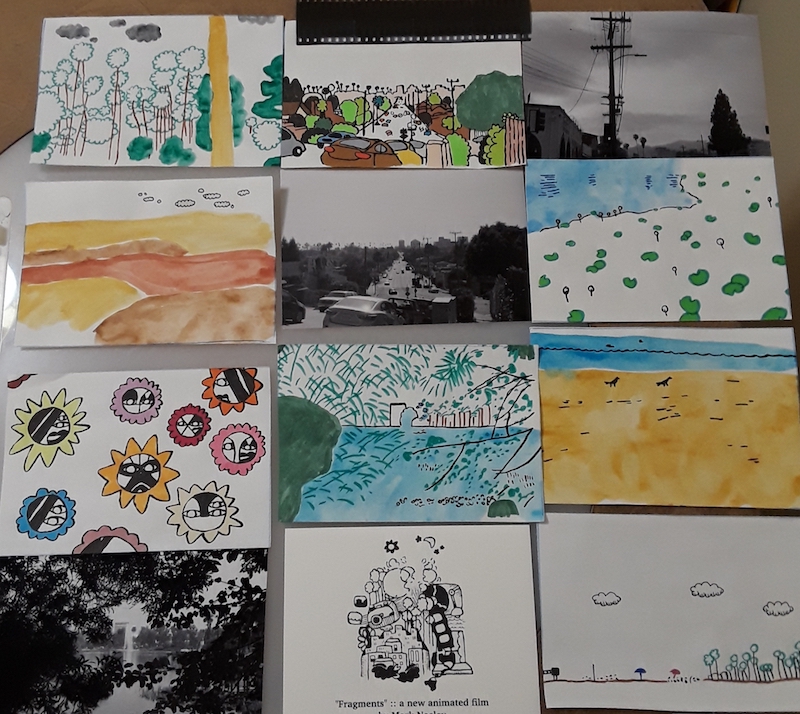
How did Fragments come about?
I had acquired an old 35mm Minolta film camera from the seventies, passed down to me by my father. It was my wife, Jaclyn, and I’s first real cross country trip together, where we went out to Los Angeles and the desert at Joshua Tree. Jaclyn studied photography in art school and took a lot of really great shots on the trip, and I got the idea to take the film slides, mount them on my lightbox and trace over top. When we got home from the trip, our cat unexpectedly passed away immediately after.
As I was working on the photograph sequence, I kept thinking about the way our emotions of this otherwise great trip would always be conflated with the sad personal event that we returned home to. The idea that we would never fully be able to seperate the two. So reluctantly, I decided to tell that part of the story and make the film a full narrative.
The soundtrack was a very important component, I wanted no dialogue and for it to be a very musical film. I reached out to Yohei Shikano, who lives in L.A. We immediately bonded over our love of Brian Wilson, and Yohei already made that kind of music which I thought was perfect for the film. There were a lot of references though, such as Jim O’Rourke’s cinematic record Eureka (1999). Yohei recorded the score in his outdoor garden studio and it was perfect. We have become close friends and collaborated a bunch since.
Fragments came out right after the pandemic hit, and to my surprise did really well at film festivals around the world. A lot of people told me it provided a sense of comfort during those times, or that they related to the theme personally. I’m very proud of the film and how it all came together.
One of my favorite moments in Fragments is when the black and white photography appears on screen, and the photos transform into animation. How did you develop the concept for that sequence?
You know, what’s funny is that originally that was supposed to be the whole film. Like I mentioned, there was originally no plan for the narrative story. When taking all of the photographs, the idea was just to get them developed and then making that sequence where they become animated, sort of a “moving sketchbook” kind of idea. But that also sort of sounded like a cheesy travelog film or something.
I wanted a mixture of some random photos and then very recognizable L.A. ones: there’s Joshua Tree, the fountain at Echo Park Lake, Laurel Canyon, and my friend Jenny standing in front of the infamous Figure 8 mural in Silver Lake. When those personal events happened, that sequence became the sort of middle of the film instead. I’m glad that part stuck with you, it was definitely supposed to be the sort of climax and foundation of the film.
One of your specialities is creating music videos, and you describe much of your work as being rooted in the “juxtaposition of sound and vision.” How do you aim to explore the connection between animation and music in your work?
The “sound & vision” thing comes from the David Bowie song. I just thought that it fit. It’s interesting because for a long time, music and animation sort of co-existed separately. I became an obsessive record collector when I was a teenager. That was a time that also broadened my horizons and made me a serious music head, being introduced to things like jazz, tropicália and world music. I had been completely swept up in the burgeoning indie rock scene that emerged from alternative and punk circles before that. For a while, that became my main hobby, going on road trips with friends to visit record stores and always digging for music, new and old.
My own art was always sort of separate from that. I think I just never thought it was possible to one day do things like animate music videos or create a record cover. There are a lot of great animated music videos that I learned about retrospectively, but I don’t really recall seeing many when I was younger. My earliest memories were things like the Strokes video for “Someday,” and I always loved that sort of ironic humor in them.
Soundtracks were always really appealing to me, and there were always really interesting ones in animation as well, like Mark Mothersbaugh’s work. I found this obscure Japanese cassette he had put out called Muzik for Insomniaks, which was this minimalist play on ambient background “muzak,” but it was extremely interesting and similar to what he was doing for his cartoon scores.
It was probably when I did my first music video, and [dealing with] the challenges of it, that I really gained a new appreciation for the art of the syncopation of sound and vision. Music is so important to me. I’d like to think that appreciation comes out in the videos, but I don’t know. For example, I did a music video for Texas-based Cactus Lee, and I made it an animated acid Western, full of essential cowboy and Western tropes. In one scene, there are a bunch of characters dancing in a saloon, and some are wearing patches that recall Gram Parsons. In my most recent video for Michael Rault, there are a lot of nods to the water sequences in Nilsson’s film The Point.
Related: Read Neeley’s appreciation of The Point on Aquarium Drunkard
How did you start working on The Aquarium Drunkard Picture Show, and what was the process like creating the introduction, intertitle shorts, and credit sequence for the show?
I had been a reader of Aquarium Drunkard since probably like 2007. They were kind enough to feature Fragments, which was a thrill for me. Shortly after, Justin Gage (the owner of AD) asked me if I wanted to partner with him to create animation for this new visual program. Apparently, Adult Swim had been interested in doing some sort of AD show for a few years. The idea was to make something in the spirit of 120 Minutes, which combined all sorts of AD-curated archival music footage with some original animation. We made the first episode, which did play on Adult Swim’s simulcast, which is their streaming channel.
That happened right on the eve of my 30th birthday, and was surreal. The Covid pandemic hit immediately after, and that was the end of that. That is my “pandemic-related missed opportunity” that every artist seems to have. But we decided, with everyone quarantined and needing things to watch, we would keep making episodes to stream online. I’m really proud of it because it was something brand new, as a visual part of Aquarium Drunkard, and it’s a blast to create animation for. And on top of that, I got to invite a few of my friends to work on it — Yohei did the music for the opening, and my pal Chelsea Wullenweber does editing on the production side.
The Aquarium Drunkard Picture Show :: Autumn Equinox (Episode 9) from Aquarium Drunkard on Vimeo.
You collaborated with Jodie Mack on one of the Aquarium Drunkard episodes. What was it like working with Jodie, and how did you both balance your different styles of animation in the work?
I’m so glad you saw that — that was probably my favorite episode that we made. It was called Autumn Equinox, which was the name of a playlist of folk music that encapsulated the feelings of that season. We reached out to a few other animators and filmmakers to produce sequences for certain songs. Jodie did an amazing sequence, experimenting with light prisms that blew me away immediately. What I love about Jodie’s work is that it is such a singular vision, and her trajectory reminds me a lot of my own, since it was also another library book (Experimental Animation) that was huge for her. There was also a great claymation scene by Owen Summers.
You’ve said that you became interested in animation at an early age. How has your relationship with animation changed over time?
If anything, it’s probably just that I have gained even more of an appreciation for it since I have become an active animator myself. There is so much great independent animation today, I wish I could keep up with it all!
Find more of Mark’s animation on his website and Vimeo
Stay up to date with all things Split Tooth Media and follow Robert on Twitter
(Split Tooth may earn a commission from purchases made through affiliate links on our site.)

